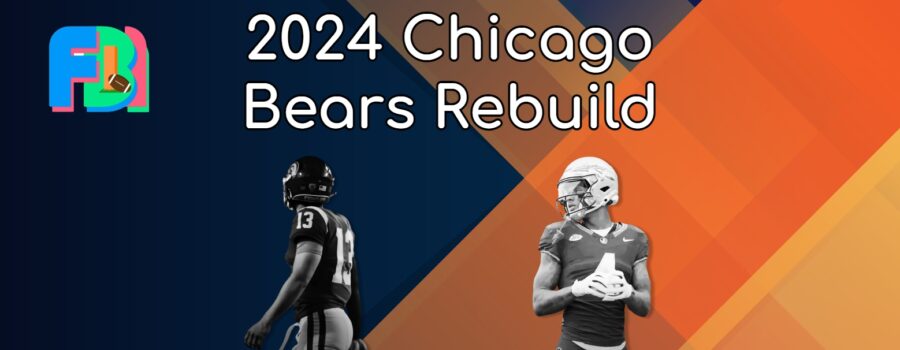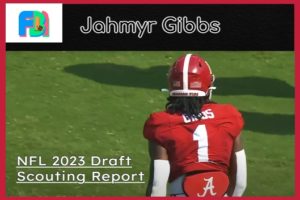The Chicago Bears are fascinating as they hold some of the best draft capital this year and have a young, talented core on offense. With the projected first and fifth overall picks, they can make a quick turnaround. In addition, they currently are launched to have 82.4 million dollars in cap space. Chicago has a passionate fan base who’s been dying to see them be relevant. In this article, I’ll do my best to rebuild the Bears by simulating the offseason. In hopes, this rebuild will put the Bears in a position to win.
Whether Matt Eberflus returns or not depends on how they finish the year. I’m projecting they won’t end the year strong in this rebuild, and Matt Eberflus and GM Ryan Poles get fired. Eberflus is a terrific defensive mind, but if the plan is to draft a QB, getting a high-end offensive play-caller is critical. Nothing against Eberflus, but he’s just not the right fit for the team.
As head coach, I’m bringing in the young Bobby Slowik. The dream candidate is Ben Johnson, but that’s unrealistic to project. I want a creative, offensive-minded coach who knows how to draw up easy first reads. Bobby Slowik is precisely that, as he’s had unexpected success with rookie C.J. Stroud. Most of that is due to how often the first read is open. The Texans’ receivers aren’t too talented, yet they’ve had a highly effective passing attack. Houston is tenth in offensive EPA when their team is very young and inexperienced, indicating he’s a skilled play-caller.
Slowik worked under Shanahan and ran a similar scheme in Houston. This scheme is best for the QB I plan on taking. I honestly can’t say how he’ll affect this culture because I haven’t interviewed him. However, everything signals he could be a head coach. I feel he inevitably gets a head coaching gig and has success. If he excelled with mediocre weapons and a rookie QB, imagine these weapons and a stud QB under his leadership.
Use promo code TREYSCHNEIDER on Underdog Fantasy to match your deposit up to $100. Please gamble responsibly and leave your feedback on Twitter @FBIntellect.
Re-Signs:
The most crucial re-signing to make for Chicago is Jaylon Johnson. He’s had an exceptional year, only allowing 162 yards through week 12. His passer rating, while targeted, is also below 38. Johnson may be limited athletically, but he is one of the best press Corners around. I’m paying him a four-year, 68 million dollar contract with 38 million fully guaranteed. It’s a lot, but he’s playing like a true number-one Corner, and this defense is already pretty poor. He’ll likely continue to improve and be a true leader on the team.
One re-sign that some wouldn’t find necessary is bringing back Darnell Mooney. As I’m eying a Receiver with that third first-rounder, Mooney won’t have as much weight on his shoulders. I want whoever I draft to have a diverse variety of options to throw to. Mooney doesn’t get much production but has an underrated skillset. He has few targets, but I believe Slowik can tap into his potential. It’s a two-year, 22-million-dollar deal with 7 million guaranteed. That allows us to move on from him after 2024 if he doesn’t work in the new system.
Lucas Patrick is a player who’d be good depth and is cheap to bring back. It only costs 2.5 million to get him back for a year. He’s a serviceable Center and can play Guard as well.
Moreover, I’m bringing back Equanimeous St. Brown on a cheap one-year deal. He’s been solid when he’s played and has experience in this new offensive system. While he may not be a starter for us, he’ll be good depth.
Cuts And Trades:
The first man to go in this scenario is Justin Fields. Some people might still stand by Fields, but I don’t think you can risk passing up this year’s QB talent to wait for him to develop. With a chance to get someone who’s a far better prospect than Fields was, it’s hard to stick with him for one more year. Furthermore, you can get a first-rounder in return for a future second and Fields. The trade saves 3.2 million and improves our draft capital immensely. While I think Fields may turn it around at some point, it didn’t work out here, and he’s best playing elsewhere.
The second guy may come as a surprise, but it’s because I have a plan for someone else in mind in the draft. I’m trading Cole Kmet to the Bengals for a second-round pick. Yes, they just gave him a contract, but no trade or cut is off the table under a new regime. Some will be upset to see this move, but there’s no point in holding on to his contract when you can get a massive upgrade in the draft. This move saves 5.2 million and will allow the new Tight End to be the full-time guy.
One cut that shouldn’t come as a surprise is Cody Whitehair. Cutting him saves 9.1 million, and some Centers would be a good fit in the draft. He’s aging and playing a replaceable position while taking up a lot of cap space. It makes too much sense, and I expect this in real life.
Free Agency:
One guy who isn’t exactly a massive free agent is Bryce Huff. I’d be hoping Brian Burns would want to join, but that would take extra draft capital as the Panthers would likely tag and trade him. Huff should be available and would be a significant upgrade. As he’s buried in depth on a talented D-Line, he hasn’t ever gotten the chance to shine. When he’s played, he’s been a high-end number-two guy. Huff’s racked up an impressive 50 pressures this year on 229 snaps. I paid him a four-year, 48 million dollar deal with 16 million guaranteed. That allows us to move on from him in two or three years if we want.
I initially planned on taking Center in the draft, but with the cap space, why not sign Connor Williams to a massive deal? Williams is from Miami and has been killing it in a wide-zone offense. He’s the perfect Center for this scheme and would allow us to invest elsewhere in the draft. It took 65 million over five years to acquire him, and I gave him 35 million guaranteed. The way I structured it only makes it a four-year deal. His cap hit will also be below 12 million in the first two years.
D’Andre Swift is someone who’d realistically be available and an excellent scheme fit. I don’t mind having Roschon Johnson play in short-yardage situations, but we need someone with plus third-down ability. Swift can be a solid check-down option in the passing game and has the speed to make some big plays in the wide-zone running game. It costs about five million to bring him in. Due to the fact he could go somewhere with a better chance of winning, it requires a little extra for Swift.
Quality run defending Linebackers are already in place here, but it would help to get another Linebacker to play on pass downs. That’s where Willie Gay comes in. He’s a linebacker from Kansas City and has outstanding athletic traits. Gay has played solid when he’s been out there and could continue to grow and flourish next to Tremain Edmunds. It only takes 16 million over two years to snag him. As he’s still unproven, giving him a two-year prove-it deal only makes sense.
The interior of the D-Line is still looking weak, so I thought it’d be wise to sign an underrated vet, Teair Tart. He played for Tennessee and helped tremendously in run defense in his stint there. Tart also has decent pass-rush ability, but we’re mainly signing him to defend the run. Because he’s not as well known, signing him only costs five million.
The depth at Corner remains a liability, and someone like Tavierre Thomas would help that. He’s an athletic Corner from Houston and is an ideal Dime Corner. Additionally, if someone gets hurt, he wouldn’t be bad as a full-time starter. Not many people know of this guy, and he’s an excellent value signing. It costs 3 million dollars to sign him, which is around what he’ll get in real life.
I’m signing Dorance Armstrong to a one-year deal to bolster the depth at EDGE. The contract costs six million dollars, but it’s worth it. He has a limited upside, though he has an underrated run-defending ability. As Huff is injury-prone and doesn’t have the best run-defense skills, we need someone who can play on run-downs and be a solid backup. Armstrong will play a much-needed role here and help this defense be complete.
After trading away Kmet, we must go after another Tight End to play in 12 personnel. Colby Parkinson can be a decent second Tight End, as he has an underrated skillset. I paid him four million dollars for just one year, and he may earn another year on top of that. He’s huge and can win in contested catch situations. If Bowers goes down, he wouldn’t be the worst starter out there, either.
Harrison Bryant is someone I thought would be a good third Tight End. From Cleveland, he has experience in a similar system and is a well-balanced player. For only four million, it doesn’t hurt to have another Tight End in case someone goes down.
George Fant would be an excellent backup Right Tackle in this offense. As he’s from Houston, he’s familiar with Slowik and should fit in. It’s always good to have a vet like him when you’re trying to develop a Tackle. He only got paid three million in 2023, so I thought a one-year, 3.5 million dollar deal was fair.
A backup QB was one of the last pieces we needed in free agency. I’d rather have someone other than Tyson Bagent, and Sam Darnold seemed like a good fit. He’s coming from a similar offense, and I feel he’s one of the better backups in the league. Costing five million for one year, we get another excellent value signing.
Geno Stone is another guy we had to pay a little extra because he’s from a top-tier team. Still, it’s only four million for one season, and he’d be a fantastic backup to Jaquan Brisker. He isn’t the most athletic but is a tough and intelligent player. Stone’s the kind of guy we’d want to help fix this culture.
Draft:
After acquiring another first-rounder from Atlanta and a second from Cincinnati, it gives us four top-50 picks. As we didn’t spend too much on free agency, it’s crucial to nail this draft. The plan is to set up a young team with many rookie contracts that a few talented vets surround. I used the PFF mock draft simulator for the mock draft, and the trades for Fields and Kmet were done on the simulator. It’s a four-round mock draft, including eight picks in total.
Round One, Pick One – QB Caleb Williams, USC
I see the argument behind taking Drake Maye, but I’m confident we can develop Caleb Williams with a talented surrounding core in place. He needs to develop his processor and weed out his inconsistencies. Although, those are things that can improve, especially in a conducive environment. His first read will be open more than not with Slowik calling plays and with this talented Receiving core. It’s not like this is a fail-proof plan, but I’d be willing to risk my job to have a top-five QB potentially.
Round One, Pick Five – TE Brock Bowers, Georgia
It would be incredible to get Marvin Harrison Jr. with this pick, but Brock Bowers still makes for a phenomenal addition as he’ll be gone. As most know, Bowers is an undersized but athletic and physical Tight End. He can be a nightmare to cover on Crossers, and with D.J. Moore here, less attention will go his way. What I love about this pick is that it improves the run game and gives Caleb another dynamic weapon. He’s been a critical component in Georgia’s running game and would do the same here. It might be wise to invest in defense with this pick. However, as long as this defense isn’t abysmal, I have faith this offense can carry us to wins.
Round One, Pick 19 (Trade W/ ATL) – WR Keon Coleman, Florida State
Some might think this is overkill, but I’m drafting another weapon with this third first-rounder. Keon Coleman can be the true deep threat this team needs, allowing Mooney to play in the Slot. Coleman has outstanding athleticism, considering he’s 6’4″. Moore is a stellar RAC threat and versatile but not a pure deep threat. That’s what Coleman can be; to go along with his speed, he has some of the best ball skills I’ve ever seen in a prospect. This pick would allow Caleb to have some of the most diverse and talented group of playmakers in the league.
Round Two, Pick 50 (Trade W/ HOU, Via CIN) – HB Jonathon Brooks, Texas
To explain how it got to this point, the second-round pick came from Cincinnati in return for Cole Kmet. Then, we traded down from pick 45 to pick 50. I thought about Jordan Morgan to add depth to the O-Line, but Jonathon Brooks has a shot to be a quality number-one back. Roschon Johnson is decent, but someone like Brooks has a higher upside. He has the speed and quickness to excel in this wide-zone system. Additionally, his third-down ability is a plus. Brooks looks like the best back in the class, and drafting him at pick 50 is excellent value.
Round Three, Pick 69 – SA Rod Moore, Michigan
This selection might be my favorite pick in this mock. Rod Moore is talented enough to go in the top 50, and we can get him in the third. He has plenty of range and instincts to play single-high Safety and can also play in the Nickell. While he missed some time in 2023, he’s given up less than 100 passing yards and has two picks. I haven’t watched his all-22 yet, but the athleticism is clearly in his highlights. He could be a solid Slot defender from day one and eventually be a stud-Free Safety.
Round Four, Pick 105 – DI Michael Hall, Ohio State
We already have two solid run defenders on the interior, though we could use another guy to rotate on pass rush downs. Michael Hall may struggle as a run defender but has the quickness and leverage advantage to win inside as a pass rusher. He’s been productive in a competitive conference and has an excellent first step. Due to his size and strength limitations, he’ll likely never be a three-down player, but you can’t go wrong taking a quality role player in the fourth. Something this squad needs is a pass-rush presence, and Hall adds that.
Round Four, Pick 118 (Trade W/ HOU) – OC Sedrick Van Pran, Georgia
This selection is somewhat of a luxury pick, and it’s best to use it to add depth to the O-Line. Sedrick Van Pran is a projected day-two pick, so getting him here is of fantastic value. He fits the scheme we’ll be running and will be a good backup. If Van Pran develops, he could possibly take over for Williams in the future. As he’s mobile and excels in blocking in the zone-running game, he’s the ideal backup Center.
Round Four, Pick 132 – WR Roman Wilson, Michigan
It’s not like a Receiver is needed here, but why not add more depth when someone like Roman Wilson is available? From what I’ve seen watching Michigan, he’s a talented deep threat with good chemistry with the QB. He’s improved his drop issues and has developed some impressive ball skills. While undersized, he’s still a dependable playmaker downfield. His game is far from refined, which is why he isn’t going higher, but he’s well worth this pick.
Conclusion:
To summarize the offseason, we moved on from Fields and Kmet, which cleared more cap and gave us an abundance of draft picks. We re-signed both Jaylon Johnson and Darnell Mooney. In free agency, we signed Bryce Huff to a safe deal and acquired Center Connor Williams on a bit more risky contract. Additionally, we got Willie Gay and Teair Tart to help support the defense. In the draft, we came away with our franchise quarterback, two dynamic offensive playmakers, and good role players on defense.
We left the offseason with 2.8 million in cap space and have a project cap of 89.4 million in 2025. I structured many contracts to give us more cap space in 2025. The plan is to see if these young players develop and strike in free agency once the team looks decent. These offseason moves put us in a position to be much more competitive while not sacrificing future cap space too much. If the draft class we put together pans out, just maybe this scenario could put Chicago in a position to compete for a Super Bowl.






Recent Comments